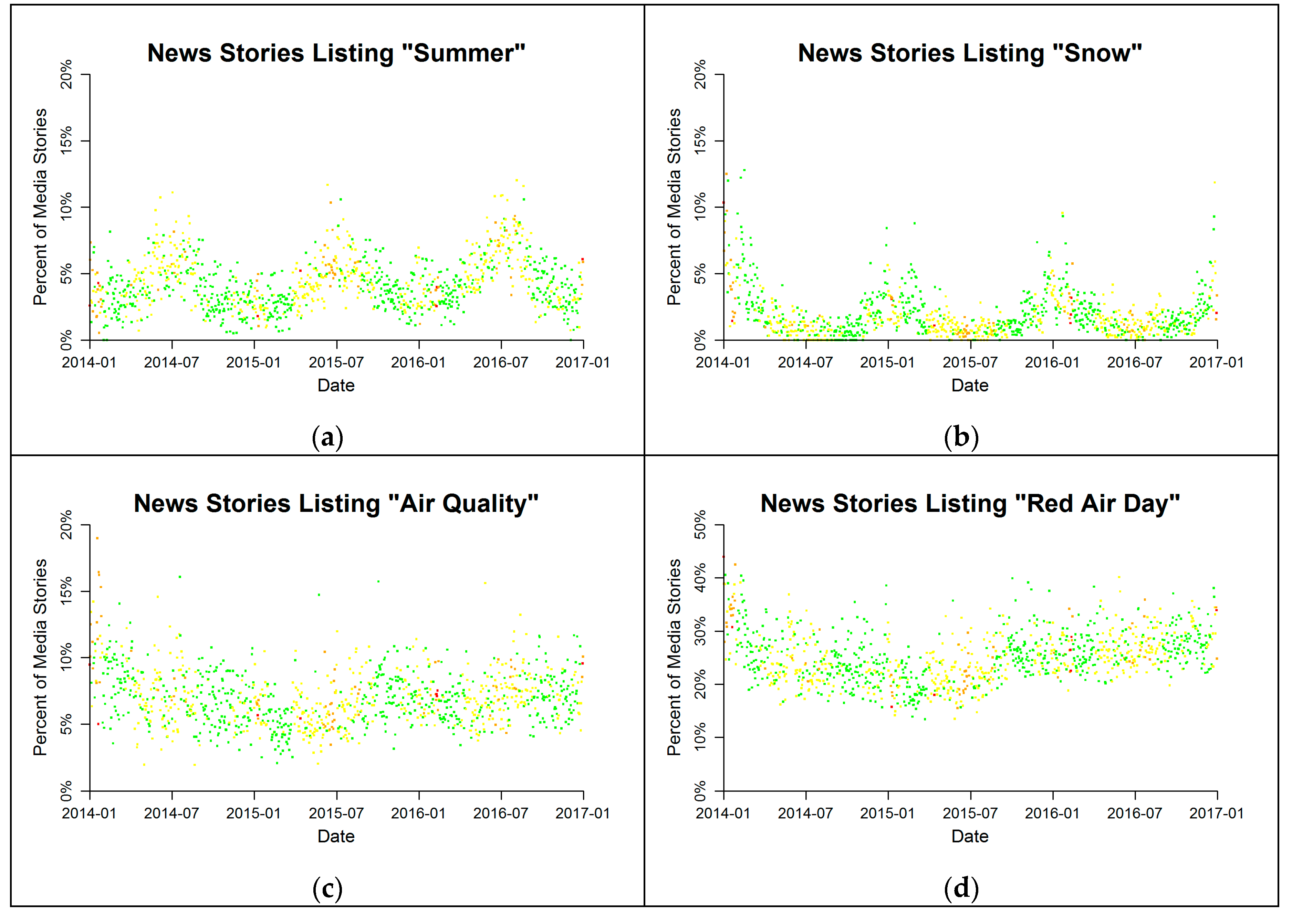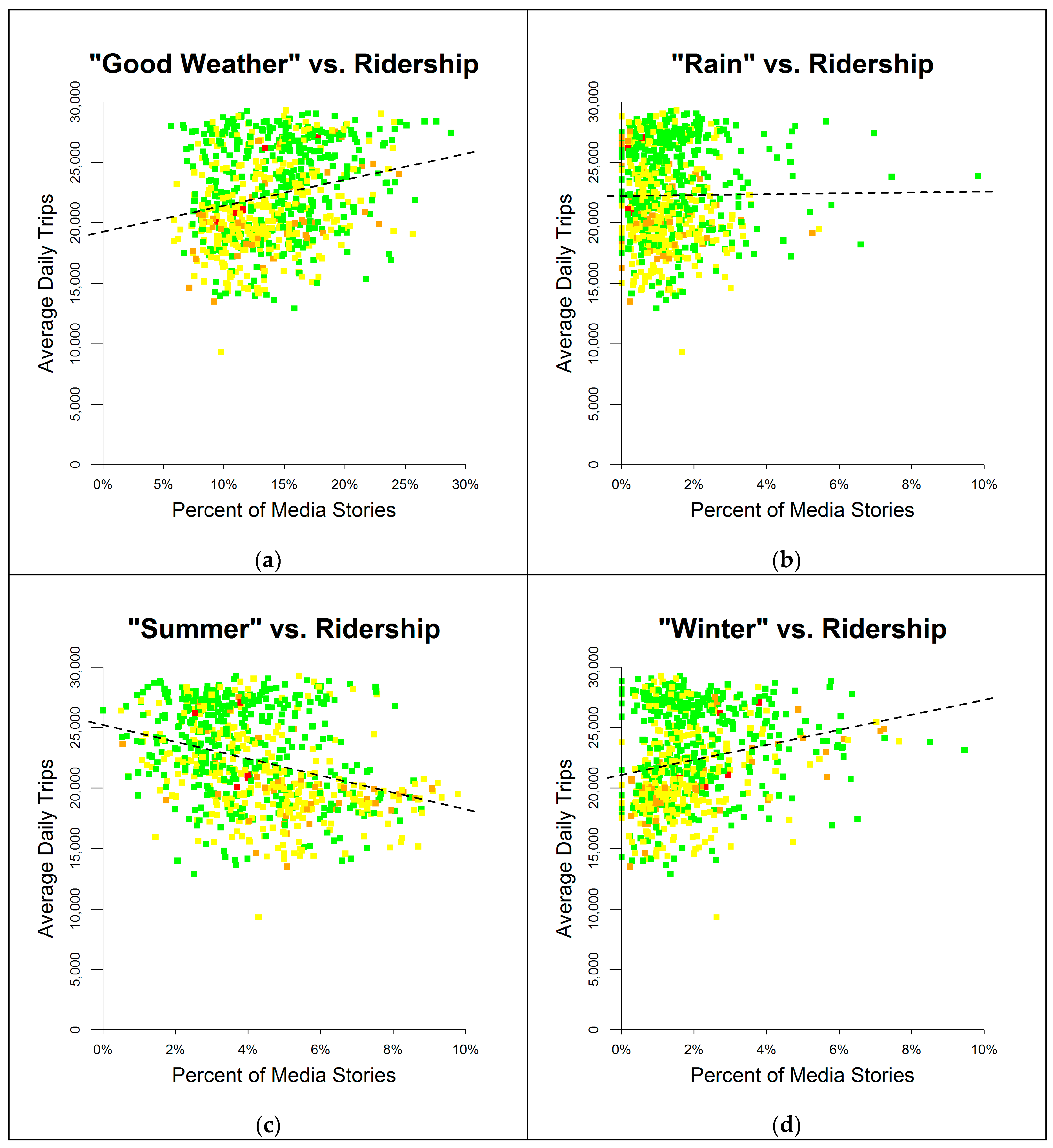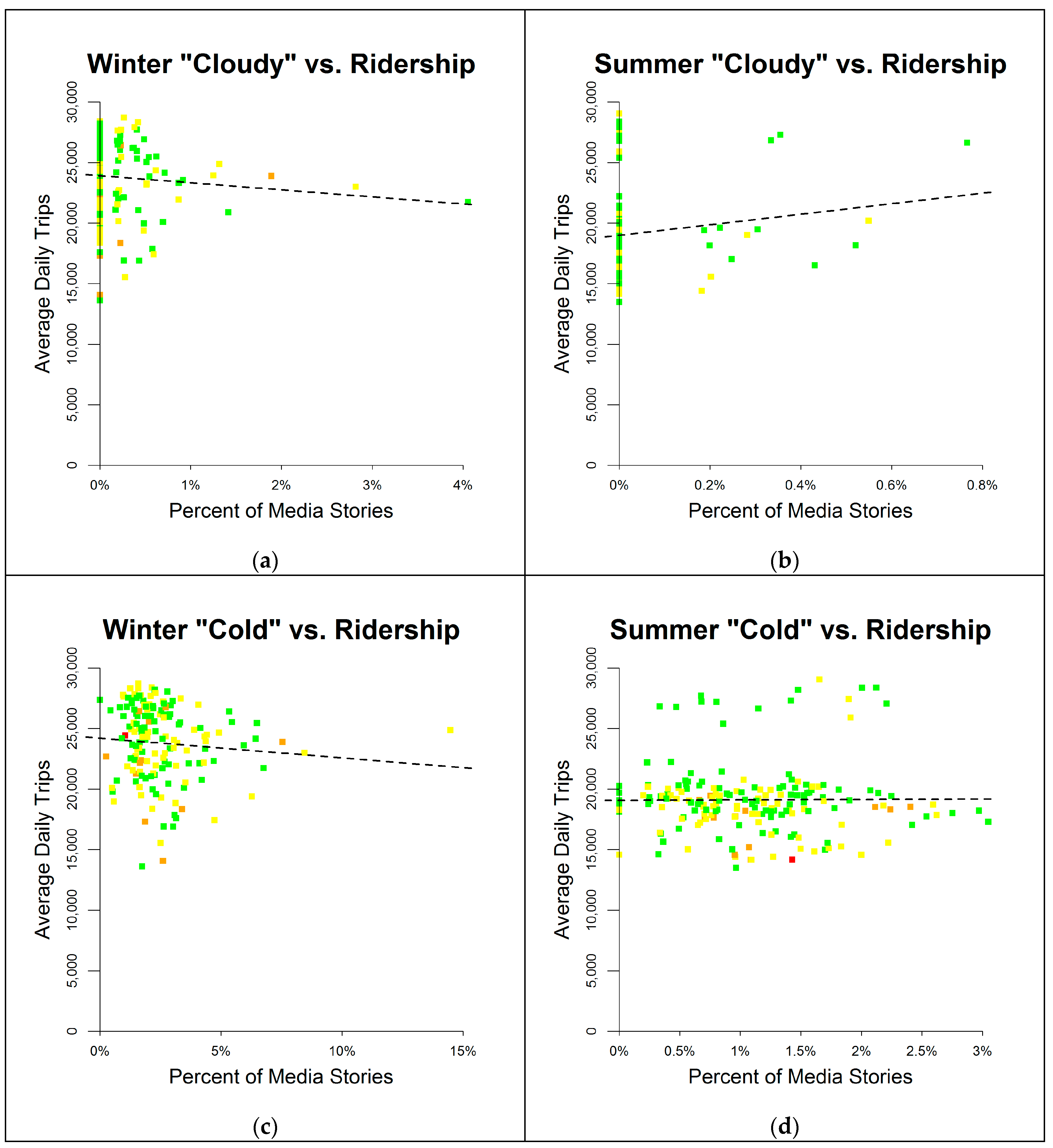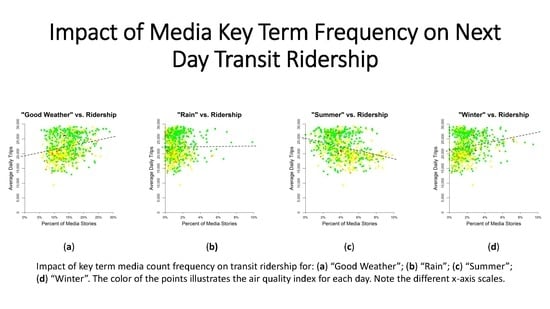The Association of Media and Environmental Variables with Transit Ridership
Abstract
:1. Introduction
1.1. Motivation
1.2. Previous Work
1.3. This Study
2. Materials and Methods
2.1. Media Data
2.2. Meteorological and Air Quality Data
2.3. Public Transit Data
2.4. Statistical Analysis
3. Results
3.1. Association between Meteorological Conditions and Media Stories
3.2. Media and Transit Ridership
3.3. Meteorological Conditions and Transit Ridership
4. Discussion
4.1. Media Key Term Usage
4.2. The Relationship between Media on Transit Ridership
4.3. Relationship between Air Quality and Transit Ridership
5. Conclusions
5.1. Implications and Future Research
5.2. Limitations
Supplementary Materials
Author Contributions
Funding
Acknowledgments
Conflicts of Interest
References
- United States Environmental Protection Agency, National Emissions Inventory (NEI). Available online: https://www.epa.gov/air-emissions-inventories/national-emissions-inventory-nei (accessed on 30 June 2020).
- Bares, R.; Lin, J.C.; Hoch, S.W.; Baasandorj, M.; Mendoza, D.L.; Fasoli, B.; Mitchell, L.; Catharine, D.; Stephens, B.B. The Wintertime Covariation of CO2 and Criteria Pollutants in an Urban Valley of the Western United States. J. Geophys. Res. Atmos. 2018, 123, 2684–2703. [Google Scholar] [CrossRef]
- Lareau, N.P.; Crosman, E.; Whiteman, C.D.; Horel, J.D.; Hoch, S.W.; Brown, W.O.J.; Horst, T.W. The Persistent Cold-Air Pool Study. Bull. Am. Meteorol. Soc. 2013, 94, 51–63. [Google Scholar] [CrossRef] [Green Version]
- Mendoza, D.L.; Crosman, E.T.; Mitchell, L.E.; Jacques, A.; Fasoli, B.; Park, A.M.; Lin, J.C.; Horel, J. The TRAX Light-Rail Train Air Quality Observation Project. Urban Sci. 2019, 3, 108. [Google Scholar] [CrossRef] [Green Version]
- Horel, J.; Crosman, E.T.; Jacques, A.; Blaylock, B.; Arens, S.; Long, A.; Sohl, J.; Martin, R. Summer ozone concentrations in the vicinity of the Great Salt Lake. Atmos. Sci. Lett. 2016, 17, 480–486. [Google Scholar] [CrossRef]
- Blaylock, B.K.; Horel, J.D.; Crosman, E.T. Impact of Lake Breezes on Summer Ozone Concentrations in the Salt Lake Valley. J. Appl. Meteorol. Climatol. 2017, 56, 353–370. [Google Scholar] [CrossRef]
- Utah Division of Air Quality. Utah’s Non Attainment Area Locator Shapefiles; Utah Division of Air Quality: Salt Lake City, UT, USA, 2018. [Google Scholar]
- Teague, W.S.; Zick, C.D.; Smith, K.R. Soft Transport Policies and Ground-Level Ozone: An Evaluation of the “Clear the Air Challenge” in Salt Lake City. Policy Stud. J. 2015, 43, 399–415. [Google Scholar] [CrossRef]
- Mendoza, D.L.; Buchert, M.P.; Lin, J.C. Modeling net effects of transit operations on vehicle miles traveled, fuel consumption, carbon dioxide, and criteria air pollutant emissions in a mid-size US metro area: Findings from Salt Lake City, UT. Environ. Res. Commun. 2019, 1. [Google Scholar] [CrossRef]
- Sun, C.; Zhang, W.; Fang, X.; Gao, X.; Xu, M. Urban public transport and air quality: Empirical study of China cities. Energy Policy 2019, 135. [Google Scholar] [CrossRef]
- Liu, Y.; Hong, Z.; Liu, Y. Do driving restriction policies effectively motivate commuters to use public transportation? Energy Policy 2016, 90, 253–261. [Google Scholar] [CrossRef]
- Liu, L.; Duan, J.; Xiao, Z.; Wang, C.; Li, X. A Fault-Tolerant Mobile Sensing Information Gathering Center (MSIGC) Using Public Transport Buses to Instrument A Smart City. In Proceedings of the 2017 9th International Conference on Advanced Infocomm Technology (ICAIT), Chengdu, China, 22–24 November 2017; pp. 233–238. [Google Scholar]
- Taylor, B.D.; Fink, C.N. The Factors Influencing Transit Ridership: A Review and Analysis of the Ridership Literature; University of California: Los Angeles, CA, USA, 2003. [Google Scholar]
- Gutiérrez, J.; Cardozo, O.D.; García-Palomares, J.C. Transit ridership forecasting at station level: An approach based on distance-decay weighted regression. J. Transp. Geogr. 2011, 19, 1081–1092. [Google Scholar] [CrossRef]
- Zillmann, D.; Bryant, J. Selective Exposure to Communication; Routledge: New York, NY, USA, 2013. [Google Scholar]
- Anderson, C.A.; Bushman, B.J. The effects of media violence on society. Science 2002, 295, 2377–2379. [Google Scholar] [CrossRef] [PubMed] [Green Version]
- Wakefield, M.A.; Loken, B.; Hornik, R.C. Use of mass media campaigns to change health behaviour. Lancet 2010, 376, 1261–1271. [Google Scholar] [CrossRef] [Green Version]
- Redman, S.; Spencer, E.A.; Sanson-Fisher, R.W. The role of mass media in changing health-related behaviour: A critical appraisal of two models. Health Promot. Int. 1990, 5, 85–101. [Google Scholar] [CrossRef]
- Van Bavel, J.J.; Baicker, K.; Boggio, P.S.; Capraro, V.; Cichocka, A.; Cikara, M.; Crockett, M.J.; Crum, A.J.; Douglas, K.M.; Druckman, J.N. Using social and behavioural science to support COVID-19 pandemic response. Nat. Hum. Behav. 2020, 4, 460–471. [Google Scholar] [CrossRef] [PubMed]
- Abroms, L.C.; Maibach, E.W. The effectiveness of mass communication to change public behavior. Annu. Rev. Public Health 2008, 29, 219–234. [Google Scholar] [CrossRef] [Green Version]
- Berkowitz, A.D. Fostering healthy norms to prevent violence and abuse: The social norms approach. In The Prevention of Sexual Violence: A Practitioner’s Sourcebook; NEARI: Holyoke, MA, USA, 2010; pp. 147–171. [Google Scholar]
- Schultz, P.W.; Nolan, J.M.; Cialdini, R.B.; Goldstein, N.J.; Griskevicius, V. The constructive, destructive, and reconstructive power of social norms. Psychol. Sci. 2007, 18, 429–434. [Google Scholar] [CrossRef] [Green Version]
- Hornik, R.; Yanovitzky, I. Using theory to design evaluations of communication campaigns: The case of the National Youth Anti-Drug Media Campaign. Commun. Theory 2003, 13, 204–224. [Google Scholar] [CrossRef] [Green Version]
- Pierce, J.P.; Macaskill, P.; Hill, D. Long-term effectiveness of the early mass media led antismoking campaigns in Australia. Am. J. Public Health 2002, 80, 57–72. [Google Scholar]
- Wallack, L.; Dorfman, L. Media advocacy: A strategy for advancing policy and promoting health. Health Educ. Q. 1996, 23, 293–317. [Google Scholar] [CrossRef]
- Yanovitzky, I.; Bennett, C. Media attention, institutional response, and health behavior change: The case of drunk driving, 1978–1996. Commun. Res. 1999, 26, 429–453. [Google Scholar] [CrossRef] [Green Version]
- Yanovitzky, I.; Stryker, J. Mass media, social norms, and health promotion efforts: A longitudinal study of media effects on youth binge drinking. Commun. Res. 2001, 28, 208–239. [Google Scholar] [CrossRef]
- Southwell, B.G.; Yzer, M.C. The roles of interpersonal communication in mass media campaigns. Ann. Int. Commun. Assoc. 2007, 31, 420–462. [Google Scholar] [CrossRef]
- Bond, R.M.; Fariss, C.J.; Jones, J.J.; Kramer, A.D.; Marlow, C.; Settle, J.E.; Fowler, J.H. A 61-million-person experiment in social influence and political mobilization. Nature 2012, 489, 295–298. [Google Scholar] [CrossRef] [PubMed] [Green Version]
- Liu, J.H.; Ban, X.; Elrahman, O. Measuring the Impacts of Social Media on Advancing Public Transit. Rensselaer 2017. [Google Scholar] [CrossRef]
- Boisjoly, G.; Grisé, E.; Maguire, M.; Veillette, M.-P.; Deboosere, R.; Berrebi, E.; El-Geneidy, A. Invest in the ride: A 14 year longitudinal analysis of the determinants of public transport ridership in 25 North American cities. Transp. Res. Part A Policy Pract. 2018, 116, 434–445. [Google Scholar] [CrossRef]
- Slater, M.D. Reinforcing spirals: The mutual influence of media selectivity and media effects and their impact on individual behavior and social identity. Commun. Theory 2007, 17, 281–303. [Google Scholar] [CrossRef]
- Sowden, A.J. Mass media interventions for preventing smoking in young people. Cochrane Database Syst. Rev. 1998. [Google Scholar] [CrossRef]
- Durkin, S.; Brennan, E.; Wakefield, M. Mass media campaigns to promote smoking cessation among adults: An integrative review. Tob. Control. 2012, 21, 127–138. [Google Scholar] [CrossRef] [Green Version]
- Yan, Q.; Tang, S.; Gabriele, S.; Wu, J. Media coverage and hospital notifications: Correlation analysis and optimal media impact duration to manage a pandemic. J. Theor. Biol. 2016, 390, 1–13. [Google Scholar] [CrossRef]
- Xiao, Y.; Zhao, T.; Tang, S. Dynamics of an infectious diseases with media/psychology induced non-smooth incidence. Math. Biosci. Eng. 2013, 10, 445. [Google Scholar]
- Díaz-Sánchez, D.; Almenarez, F.; Marín, A.; Proserpio, D.; Cabarcos, P.A. Media cloud: An open cloud computing middleware for content management. IEEE Trans. Consum. Electron. 2011, 57, 970–978. [Google Scholar] [CrossRef]
- Horel, J.; Splitt, M.; Dunn, L.; Pechmann, J.; White, B.; Ciliberti, C.; Lazarus, S.; Slemmer, J.; Zaff, D.; Burks, J. Mesowest: Cooperative Mesonets in the Western United States. Bull. Am. Meteorol. Soc. 2002, 83, 211–225. [Google Scholar] [CrossRef]
- United States Environmental Protection Agency Air Quality Index (AQI) Basics. Available online: https://airnow.gov/index.cfm?action=aqibasics.aqi (accessed on 30 June 2020).
- United States Environmental Protection Agency. Air Data Pre-Generated Data Files; United States Environmental Protection Agency: Washington, DC, USA, 2020.
- Jakus, P.M.; Kim, M.-K.; Martin, R.C.; Hammond, I.; Hammill, E.; Mesner, N.; Stout, J. Wildfire in Utah: The Physical and Economic Consequences of Wildfire; Utah State University: Logan, UT, USA, 2017. [Google Scholar]
- Kim, J.Y.; Bartholomew, K.; Ewing, R. Impacts of Bus Stop Improvements; Utah Department of Transportation Research Division: Salt Lake City, UT, USA, 2018.
- Briscoe, J. HB 0353: Reduction of Single Occupancy Vehicle Trips Pilot Program. 2019. Available online: https://le.utah.gov/~2019/bills/static/HB0353.html (accessed on 30 June 2020).




| Air Quality | Higher Temperature | Orange Air Day | Storm |
|---|---|---|---|
| Bad weather | Hot | Ozone | Summer |
| Cloudy | Hotter | Particulate matter | Sun |
| Cold | Hotter weather | PM2.5 | Sunny |
| Freezing | Inversion | Rain | Winter |
| Green air day | Low temperature | Red air day | Winter storm |
| Heat wave | Lower temperature | Snow | Yellow air day |
| Media Type | Count | Description |
|---|---|---|
| Digital Native | 4 | Internet based source. Includes news sources that began on the internet such as organizational websites and blogs. Examples: CDC, Vox, Scroll |
| Print Native | 24 | Primarily print-based publication. Includes newspapers and magazines. Examples: New York Times, The Economist. |
| Video Broadcast | 12 | Primarily broadcast TV station media such as video transcriptions or closed captions. Examples: CNN, Fox News. |
| Bus Commute Trips | |||||||||||||||||
|---|---|---|---|---|---|---|---|---|---|---|---|---|---|---|---|---|---|
| AQ | Ann | Win | Spr | Sum | Fall | Jan | Feb | Mar | Apr | May | Jun | Jul | Aug | Sep | Oct | Nov | Dec |
| G-Y | 0.00 *** | 0.97 | 0.05 * | 0.41 | 1.00 | 0.20 | 0.72 | 0.89 | 0.90 | 0.69 | 0.11 | 0.87 | 0.31 | 0.39 | 0.01 * | 0.35 | 0.46 |
| G-O | 0.00 *** | 0.89 | NA | 0.61 | NA | 0.03 * | 0.06 | NA | NA | NA | 0.00 ** | 0.99 | 0.02 * | NA | NA | NA | NA |
| G-R | 0.59 | 0.57 | NA | NA | NA | NA | 0.28 | NA | NA | NA | NA | NA | NA | NA | NA | NA | NA |
| Y-O | 0.27 | 0.85 | NA | 0.64 | NA | 0.13 | 0.08 | NA | NA | NA | 0.08 | 0.94 | 0.07 | NA | NA | NA | NA |
| Y-R | 0.05 * | 0.49 | NA | NA | NA | NA | 0.29 | NA | NA | NA | NA | NA | NA | NA | NA | NA | NA |
| O-R | 0.01 * | 0.61 | NA | NA | NA | NA | 0.39 | NA | NA | NA | NA | NA | NA | NA | NA | NA | NA |
| Bus Non-Commute Trips | |||||||||||||||||
| AQ | Ann | Win | Spr | Sum | Fall | Jan | Feb | Mar | Apr | May | Jun | Jul | Aug | Sep | Oct | Nov | Dec |
| G-Y | 0.00 *** | 0.33 | 0.04 * | 0.66 | 0.94 | 0.14 | 0.39 | 0.90 | 0.39 | 0.98 | 0.21 | 0.45 | 0.55 | 0.09 | 0.02 * | 0.31 | 0.56 |
| G-O | 0.00 *** | 0.54 | NA | 0.54 | NA | 0.02 * | 0.04 * | NA | NA | NA | 0.02 * | 0.89 | 0.05 * | NA | NA | NA | NA |
| G-R | 0.65 | 0.47 | NA | NA | NA | NA | 0.09 | NA | NA | NA | NA | NA | NA | NA | NA | NA | NA |
| Y-O | 0.09 | 0.98 | NA | 0.78 | NA | 0.20 | 0.05 * | NA | NA | NA | 0.21 | 0.71 | 0.07 | NA | NA | NA | NA |
| Y-R | 0.05 * | 0.27 | NA | NA | NA | NA | 0.10 | NA | NA | NA | NA | NA | NA | NA | NA | NA | NA |
| O-R | 0.00 ** | 0.36 | NA | NA | NA | NA | 0.57 | NA | NA | NA | NA | NA | NA | NA | NA | NA | NA |
| Front Runner Commute Trips | |||||||||||||||||
|---|---|---|---|---|---|---|---|---|---|---|---|---|---|---|---|---|---|
| AQ | Ann | Win | Spr | Sum | Fall | Jan | Feb | Mar | Apr | May | Jun | Jul | Aug | Sep | Oct | Nov | Dec |
| G-Y | 0.00 *** | 0.74 | 0.00 *** | 0.34 | 0.50 | 0.19 | 0.82 | 0.48 | 0.68 | 0.24 | 0.06 | 0.66 | 0.27 | 0.80 | 0.02 * | 0.05 | 0.98 |
| G-O | 0.00 *** | 0.76 | NA | 0.38 | NA | 0.12 | 0.13 | NA | NA | NA | 0.01 * | 0.86 | 0.11 | NA | NA | NA | NA |
| G-R | 0.37 | 0.86 | NA | NA | NA | NA | 0.61 | NA | NA | NA | NA | NA | NA | NA | NA | NA | NA |
| Y-O | 0.86 | 0.88 | NA | 0.99 | NA | 0.50 | 0.12 | NA | NA | NA | 0.33 | 0.66 | 0.26 | NA | NA | NA | NA |
| Y-R | 0.74 | 0.73 | NA | NA | NA | NA | 0.75 | NA | NA | NA | NA | NA | NA | NA | NA | NA | NA |
| O-R | 0.71 | 0.69 | NA | NA | NA | NA | 0.37 | NA | NA | NA | NA | NA | NA | NA | NA | NA | NA |
| Front Runner Non-Commute Trips | |||||||||||||||||
| AQ | Ann | Win | Spr | Sum | Fall | Jan | Feb | Mar | Apr | May | Jun | Jul | Aug | Sep | Oct | Nov | Dec |
| G-Y | 0.00 *** | 0.77 | 0.00 *** | 0.12 | 0.40 | 0.31 | 0.95 | 0.60 | 0.63 | 0.08 | 0.01 ** | 0.54 | 0.10 | 0.59 | 0.00 ** | 0.11 | 0.78 |
| G-O | 0.00 *** | 0.96 | NA | 0.01 * | NA | 0.12 | 0.00 *** | NA | NA | NA | 0.01 * | 0.42 | 0.00 *** | NA | NA | NA | NA |
| G-R | 0.65 | 0.90 | NA | NA | NA | NA | 0.44 | NA | NA | NA | NA | NA | NA | NA | NA | NA | NA |
| Y-O | 0.48 | 0.89 | NA | 0.01 | NA | 0.32 | 0.10 | NA | NA | NA | 0.78 | 0.31 | 0.02 * | NA | NA | NA | NA |
| Y-R | 0.20 | 0.97 | NA | NA | NA | NA | 0.48 | NA | NA | NA | NA | NA | NA | NA | NA | NA | NA |
| O-R | 0.07 | 0.92 | NA | NA | NA | NA | 0.53 | NA | NA | NA | NA | NA | NA | NA | NA | NA | NA |
| TRAX Commute Trips | |||||||||||||||||
|---|---|---|---|---|---|---|---|---|---|---|---|---|---|---|---|---|---|
| AQ | Ann | Win | Spr | Sum | Fall | Jan | Feb | Mar | Apr | May | Jun | Jul | Aug | Sep | Oct | Nov | Dec |
| G-Y | 0.00 *** | 0.68 | 0.01 * | 0.07 | 0.83 | 0.12 | 0.76 | 0.34 | 0.67 | 0.29 | 0.06 | 0.66 | 0.04 * | 0.87 | 0.02 * | 0.15 | 0.85 |
| G-O | 0.00 *** | 0.87 | NA | 0.00 ** | NA | 0.05 | 0.32 | NA | NA | NA | 0.70 | 0.18 | 0.00 *** | NA | NA | NA | NA |
| G-R | 0.42 | 0.43 | NA | NA | NA | NA | 0.83 | NA | NA | NA | NA | NA | NA | NA | NA | NA | NA |
| Y-O | 0.15 | 0.92 | NA | 0.12 | NA | 0.43 | 0.20 | NA | NA | NA | 0.25 | 0.19 | 0.02 * | NA | NA | NA | NA |
| Y-R | 0.54 | 0.46 | NA | NA | NA | NA | 0.99 | NA | NA | NA | NA | NA | NA | NA | NA | NA | NA |
| O-R | 0.23 | 0.46 | NA | NA | NA | NA | 0.36 | NA | NA | NA | NA | NA | NA | NA | NA | NA | NA |
| TRAX Non-Commute Trips | |||||||||||||||||
| AQ | Ann | Win | Spr | Sum | Fall | Jan | Feb | Mar | Apr | May | Jun | Jul | Aug | Sep | Oct | Nov | Dec |
| G-Y | 0.00 *** | 0.27 | 0.01 * | 0.06 | 0.40 | 0.14 | 0.31 | 0.39 | 0.11 | 0.35 | 0.07 | 0.43 | 0.08 | 0.63 | 0.09 | 0.88 | 0.73 |
| G-O | 0.00 *** | 0.20 | NA | 0.00 ** | NA | 0.05 * | 0.68 | NA | NA | NA | 0.76 | 0.12 | 0.00 ** | NA | NA | NA | NA |
| G-R | 0.53 | 0.28 | NA | NA | NA | NA | 0.66 | NA | NA | NA | NA | NA | NA | NA | NA | NA | NA |
| Y-O | 0.03 * | 0.63 | NA | 0.04 * | NA | 0.46 | 0.31 | NA | NA | NA | 0.11 | 0.04 * | 0.04 * | NA | NA | NA | NA |
| Y-R | 0.37 | 0.56 | NA | NA | NA | NA | 0.74 | NA | NA | NA | NA | NA | NA | NA | NA | NA | NA |
| O-R | 0.06 | 0.78 | NA | NA | NA | NA | 0.41 | NA | NA | NA | NA | NA | NA | NA | NA | NA | NA |
© 2020 by the authors. Licensee MDPI, Basel, Switzerland. This article is an open access article distributed under the terms and conditions of the Creative Commons Attribution (CC BY) license (http://creativecommons.org/licenses/by/4.0/).
Share and Cite
Mendoza, D.L.; Buchert, M.P.; Benney, T.M.; Lin, J.C. The Association of Media and Environmental Variables with Transit Ridership. Vehicles 2020, 2, 507-522. https://0-doi-org.brum.beds.ac.uk/10.3390/vehicles2030028
Mendoza DL, Buchert MP, Benney TM, Lin JC. The Association of Media and Environmental Variables with Transit Ridership. Vehicles. 2020; 2(3):507-522. https://0-doi-org.brum.beds.ac.uk/10.3390/vehicles2030028
Chicago/Turabian StyleMendoza, Daniel L., Martin P. Buchert, Tabitha M. Benney, and John C. Lin. 2020. "The Association of Media and Environmental Variables with Transit Ridership" Vehicles 2, no. 3: 507-522. https://0-doi-org.brum.beds.ac.uk/10.3390/vehicles2030028








